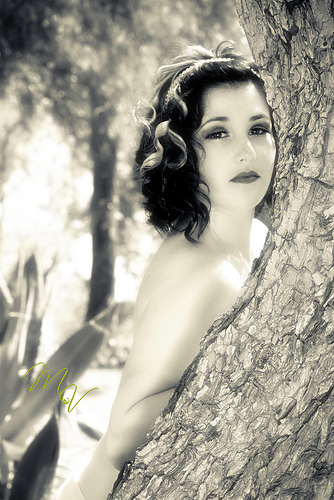Artists, not starving: Two successful creators take to the web to spread their works

Shellie Vickrey describes herself as a fine art lifestyle photographer who looks beyond what other people to see to create beautiful renditions.
"I want the client to walk away feeling more beautiful, sexy and dreamy than they ever thought possible," she said. "I paint with light and try to make the final photograph a work of sensual art unto itself."

This success is no different than what many artists are experiencing in the age of social media for business. The most often told stories of social media success are generally large process-oriented depictions of business to business or business to consumer case studies. In the art world, the use of social media is much more fluid yet just as successful. From word of mouth marketing to strategic use of social networks, artists like Vickrey have opened an entirely new form of engagement through art.
"Word of mouth has always been the best way to market my work. I honestly rarely use a business card," Vickrey said. "However, I have been using social media and the web since long before I was a photography hobbyist and long before it was my full-time business. I owned a clothing line for 10 years and used social media to learn as much as I could about fashion, models, photography, trends, style, photographers and the business."
Natasha Wescoat is another artist who has been favorably rewarded by her early adoption of social media for promoting her work. She paints what she calls whimsical pop art, with acrylic on canvas and even sometimes illustration and character work. In the beginning she fell into social media promotion of her art almost by accident through video.
Regardless of whether or not this was a planned strategy, it worked for Wescoat. One of the elements of gallery showings and the like which never appealed to Wescoat was their impersonal nature. Social media has allowed her to connect personally with fans and potential collectors. She gives examples about how social media could help artists connect with fan bases in other countries, or even with audiences that may not fall into any one targeted demographic.
"Social media is a great experimentation to help gauge where your audience may be," she said.
Next: Designing a promotion plan -->
Vickrey is seeing the same opportunity for artists, especially in the photography world. She said that while many photographers have Twitter, Facebook, Flickr or MySpace accounts, many of them are not using them effectively to market their work.
"I think it is important to have the correct tools to grow your fan base and clientele, to market your business and measure your efforts," Vickrey said. "When done correctly, social media enables artists to engage in dialogue and build a following."
Wescoat sees the same, stating that even the most successful traditional artists are moving toward the web because its helping to eliminate the costly middle man. She said that when initially considering gallery showings, few artists consider the major costs of doing an art gallery show: supplies, set-up, commission to the gallery, advertising and promotion, catering, venue, and so on.
"With the web, we are not only cutting costs, we are making it possible for our collectors to know us, and for us to know them. There's a stronger brand builder possible there," she said. "You're no longer stuck within the confines of traditional art market rules and manners. You determine where you want to go with your work."
Where on the Web do artists get started? There are a myriad of places that include, and go well beyond, traditional social networks. Vickrey gets a lot of exposure through her Facebook fan page, Twitter, LinkedIn and her blog, and also uses sites such as Model Mayhem, Etsy, Zazzle, ViewBug, Digg and MySpace.
"These sites have promoted my work, allowed me to enter contests, educate myself, share tutorials and gain great exposure," she said.
Wescoat has gone an even more untraditional route with partnerships with sites such as Overstock.com, and said that she's been able to create a loyal fanbase that follows her whereever she goes.
This success is not without its challenges. Vickrey says that it's a bear at times to constantly manage all of her sites, between doing photoshoots and running her studio.
"You have to make the time to constantly keep showing the world what you area about, what you do and what services you offer," she said. "If you can just take one hour out of your day to share a little bit of your work then you have done your job."
Wescoat stresses that research is key, too, as is preparation.
"Read everything you can, build your collection of work first and get to know the people around you and online," she said. "Coming into this fresh and new is always scary and people will not trust you at first. It takes time, just like in the normal world, to build a fan base and a group of friends who will look out for you in this business. If you are doing your research, and experimenting on your own, you will get to where you want to be."
Photographs by Shellie Vickrey. Paintings by Natasha Wescoat.